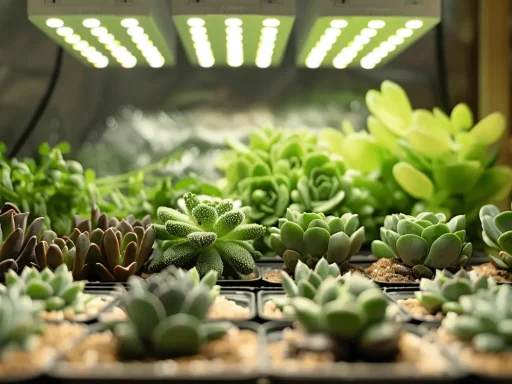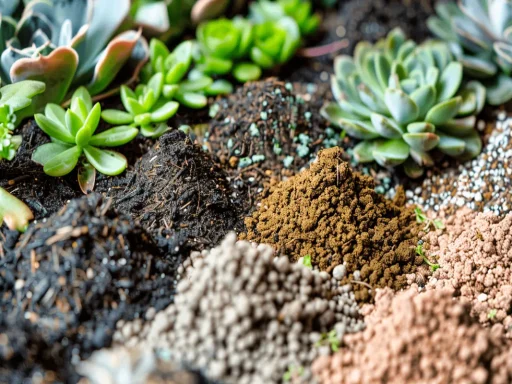Did you know that up to 95% of succulent deaths are attributed to root rot? Identifying the early signs of this condition can be the difference between saving your beloved plants or losing them altogether.
As you observe your succulents, noticing subtle changes in their appearance may signal underlying issues that need your attention. Let’s explore the subtle hints that your succulent may be giving you, indicating the presence of root rot and how to intervene effectively.
Table of Contents
Discolored or Mushy Leaves

If you notice discolored or mushy leaves on your succulents, it could be an early sign of root rot. Discolored leaves on succulents are a common indicator of deteriorating root health. These leaves may appear mushy, discolored, or even translucent. When touched, mushy leaves will feel soft and waterlogged, signaling potential root damage.
The discoloration in the leaves typically starts as yellowing and can progress to browning as root rot advances. This deterioration in root health due to root rot manifests first in the leaves, with discoloration spreading from the bottom of the plant upwards. By observing changes in leaf texture, color, and firmness, you can identify root rot early on and take steps to prevent further damage to your succulent.
Keeping a close eye on the condition of your plant’s leaves is crucial in maintaining its overall health and well-being.
Smelly or Foul Odor
A foul or smelly odor emanating from your succulent’s soil or roots can be a clear indication of underlying root rot issues. When you detect this unpleasant smell, it’s often musty or moldy, suggesting that the roots are decomposing due to overwatering.
The gases released during the process of root rot contribute to this foul odor. Recognizing this smell is one of the key signs of root rot, signaling that immediate action is necessary to save your plant.
Regularly checking for and addressing foul odors can help prevent the spread of root rot and further damage to your succulent. Remember, addressing the root cause of the issue is crucial to ensure the health and longevity of your succulent.
Don’t ignore the signs; take proactive steps to investigate and treat root rot promptly to give your plant the best chance of recovery.
Soft or Soggy Stem
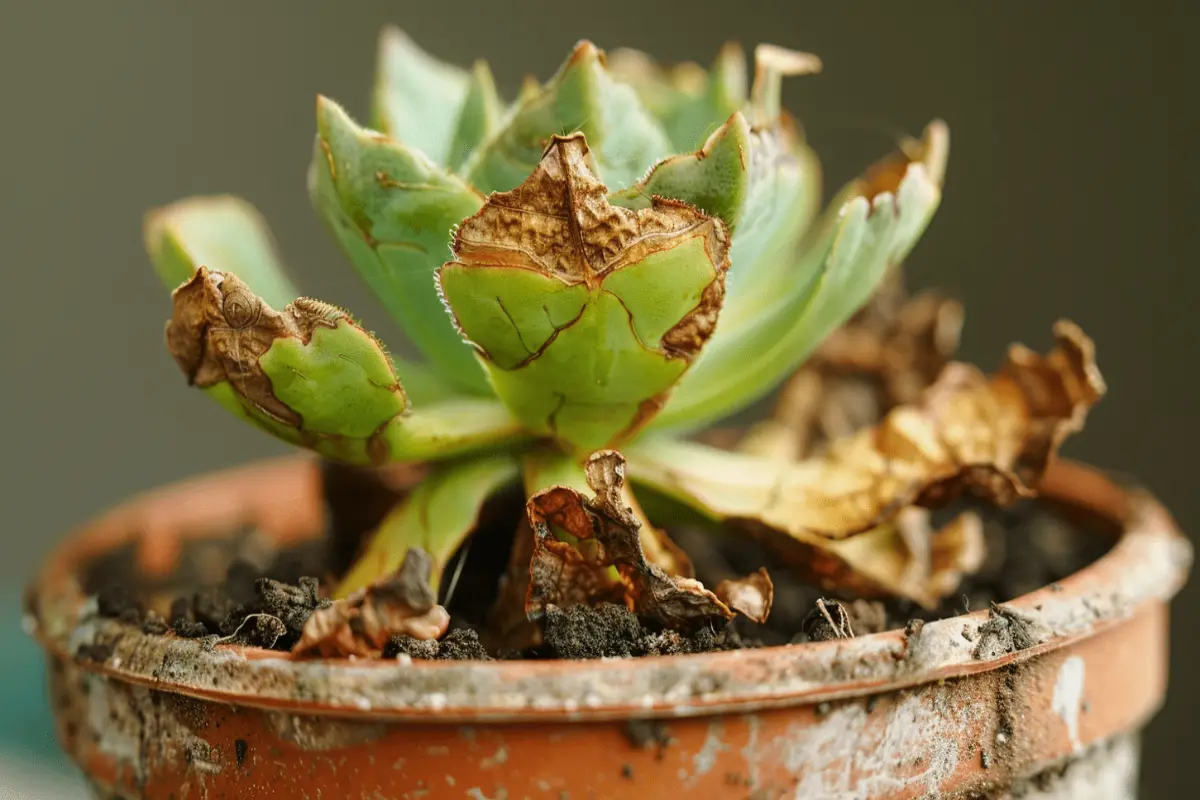
When noticing a soft or soggy stem in your succulent, it often signals potential root rot issues caused by excessive moisture. The softness in the stem is a clear indication that the roots are struggling to cope with the amount of water they’re receiving.
Here are some key points to consider:
- Root Rot: Soft or soggy stems are commonly linked to root rot, a condition that can be detrimental to the overall health of your succulent.
- Softness: The stem may feel mushy or squishy to the touch, indicating that the root system is compromised.
- Succulents: These plants are particularly susceptible to root rot if overwatered, as their roots aren’t adapted to handle excessive moisture.
- Wilting: Softness in the stem can lead to wilting of the leaves and a general decline in the plant’s appearance.
- Immediate Action: It’s crucial to take immediate action to address the root cause of the issue and prevent further damage to your succulent. Regularly checking the firmness of the stem can help detect root rot early for effective treatment.
Wilting or Drooping Appearance
If your succulent starts to wilt or droop, it could be a sign of root rot due to excessive watering.
The leaves may lose their typical firmness and appear limp, indicating a potential issue with the plant’s roots.
Taking action early by checking for mushy roots can help prevent further damage and rescue your succulent from root rot.
Yellowing Leaves
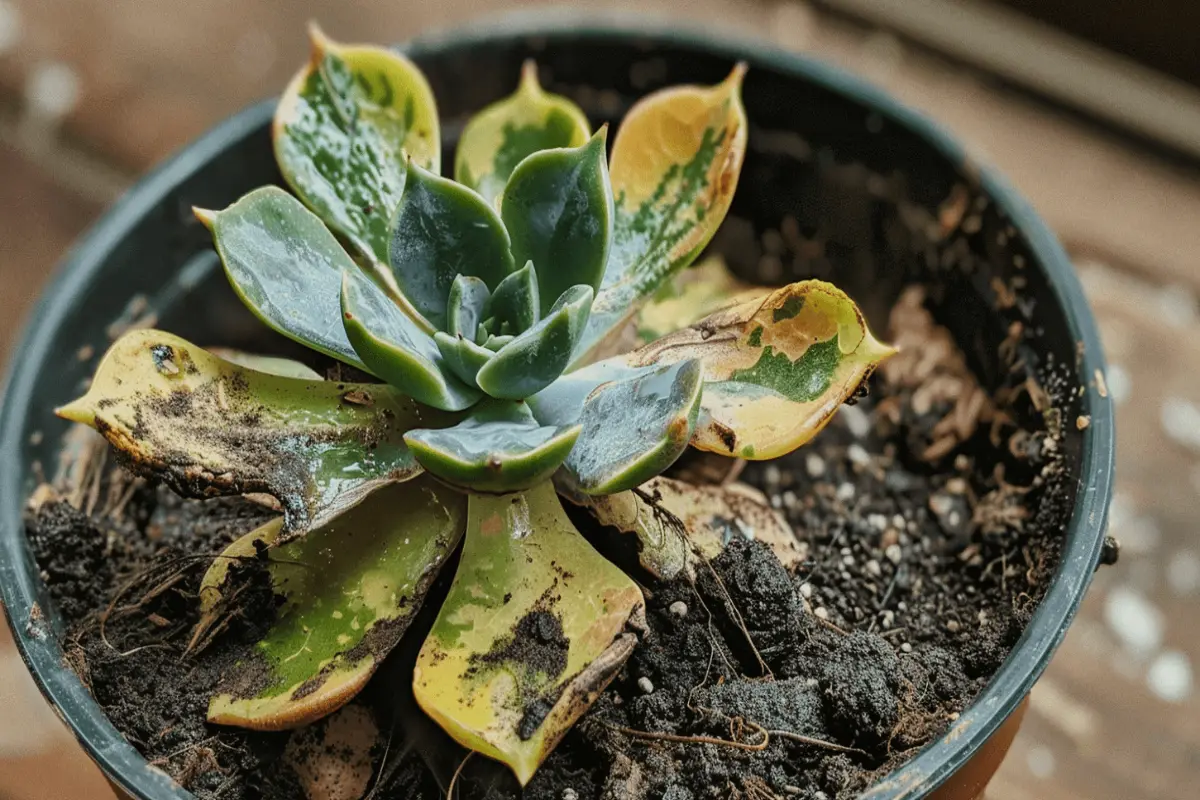
Yellowing leaves on succulents signal potential root rot due to overwatering, leading to oxygen deprivation for the roots. This yellowing may begin at the lower leaves and gradually move upwards as the root rot progresses.
The wilting or drooping appearance of the leaves is a clear early indicator of succulent root rot, highlighting an unhealthy root system. Addressing the issue promptly can prevent further damage and potential loss of the plant.
To effectively recognize and combat root rot in succulents, keep an eye out for these signs:
- Yellowing leaves at the base of the plant
- Progression of yellowing towards the top
- Wilting or drooping of the leaves
- Lack of oxygen reaching the roots
- Importance of timely intervention
Soft, Mushy Stems
Soft, mushy stems in succulents signal the presence of root rot and often manifest in a wilting or drooping appearance. The softness in the stems is a result of root decay and damage, causing a lack of structural support for the plant.
Wilting or drooping stems serve as early visible indicators of root rot, prompting immediate intervention to save the succulent. If left untreated, the softness in the stems can spread, impacting the overall health and stability of the plant.
Promptly addressing soft, mushy stems by treating the root rot can prevent further deterioration and potential loss of the succulent. Remember, quick action is crucial when you notice these signs to give your succulent the best chance of recovery.
Leaf Discoloration Signs

Early signs of succulent root rot may manifest as yellowing or browning of leaves, indicating potential issues with overwatering or inadequate drainage. When you notice yellowing leaves, browning leaves, or mushy, wilted leaves on your succulent, it’s crucial to act promptly to save your plant.
Keep an eye on the bottom leaves as discoloration typically starts there and progresses upwards with the spread of root rot. Detecting leaf discoloration early is key to preventing further damage and increasing the chances of recovery. By monitoring changes in leaf color, you can identify root rot in its early stages and take necessary steps to address the problem effectively.
- Yellowing leaves
- Browning leaves
- Mushy or wilted leaves
- Prompt action is crucial
- Early detection saves succulents
Visual Indicators of Rot
Monitoring changes in leaf color serves as a crucial visual indicator for detecting early signs of succulent root rot. Yellowing or browning leaves can signal stress and potential root damage, affecting nutrient absorption.
Yellowing leaves indicate stress and potential root damage, affecting the plant’s ability to absorb nutrients. Browning of lower leaves can be a sign of root rot impeding proper nutrient absorption. If you notice yellowing at the top of the plant, it may suggest root rot impacting the nutrient absorption process.
These visual cues, such as yellowing or browning leaves, should prompt you to inspect the plant closely to confirm the presence of root rot. By staying vigilant and observing leaf color changes, you can catch succulent root rot early and prevent further damage.
This proactive approach to monitoring leaf color changes can help you intervene early, potentially saving your succulent from severe root rot damage.
Slow Growth or Stunted Development

Experiencing slow growth or stunted development in your succulents could signal an underlying root rot issue affecting their overall health. When you notice your plants failing to thrive as expected, it might be time to investigate the possibility of root rot. Here’s what to look out for:
- Limited Leaf Production: Succulents affected by root rot may exhibit reduced leaf growth, affecting their overall size and appearance.
- Lack of New Growth: A lack of fresh shoots or minimal expansion in your succulents could be a red flag for root damage caused by rot.
- Stunted Growth: If your succulents seem smaller or underdeveloped compared to their usual growth rate, root rot may be impeding their ability to absorb essential nutrients and water.
- Nutrient and Water Absorption Issues: Root rot can hinder the plant’s capacity to uptake nutrients and moisture efficiently, leading to stunted development.
- Prompt Inspection: Observing slow or limited growth should prompt a thorough check for root rot symptoms to prevent further deterioration.
Natural Bug, Insect & Pest Killer & Control Including Fleas, Ticks, Ants, Spiders, Bed Bugs, Dust Mites, Roaches and More for Indoor and Outdoor Use, 128 Oz Gallon
Black Spots on Leaves or Stem
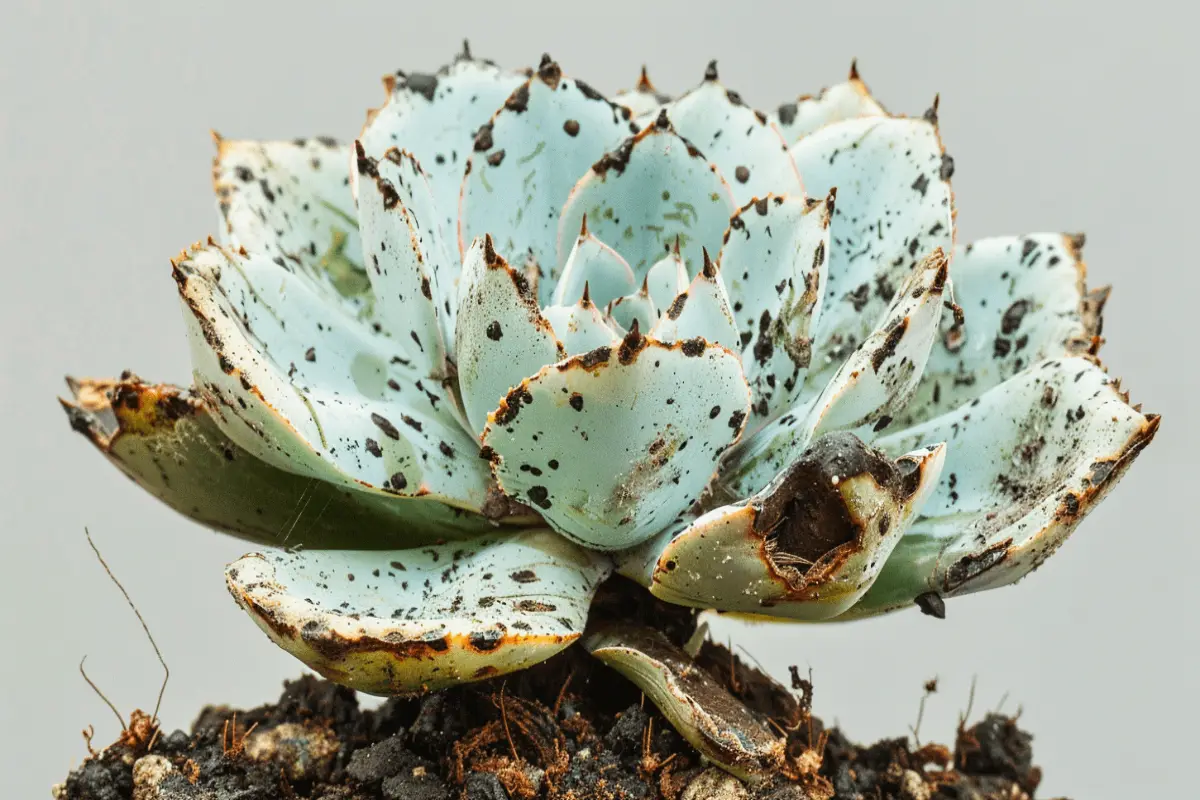
If you notice black spots on the leaves or stem of your succulent, it could be a sign of root rot likely caused by overwatering. These black spots are a common indicator of root rot in succulents.
The black spots may feel mushy or soft when touched, indicating damage and decay in the affected areas. If left unaddressed, these black spots can quickly spread, impacting the overall health and appearance of your succulent.
Root rot is a serious issue that can cause the black spots on the leaves or stem to progress into larger areas of decay. It’s crucial to monitor your succulent closely and identify any black spots promptly to prevent further damage.
By recognizing these early signs of root rot, you can take action to save your succulent from deteriorating. Remember, overwatering is often the primary cause of root rot in succulents, so adjusting your watering practices may help prevent black spots and root rot in the future.
Excessive Leaf Loss
Excessive leaf loss in succulents can indicate early stages of root rot, signaling stress on the plant. When you notice your succulent shedding an excessive number of leaves, it could be a red flag for root rot. This phenomenon occurs because the roots are being compromised by the rot, hindering their ability to support the plant adequately.
Here are some key points to consider regarding excessive leaf loss in succulents:
- Early Warning: Excessive leaf loss serves as an early warning sign of potential root rot issues.
- Nutrient Absorption: Root rot affects the succulent’s ability to absorb nutrients, leading to rapid leaf shedding.
- Energy Conservation: Succulents drop leaves to conserve energy when root rot impacts their nutrient uptake.
- Progression Indicator: Wilting, yellowing, and significant leaf drop can indicate the progression of root rot.
- Prompt Action: Monitoring leaf loss patterns enables early identification of root rot, allowing for timely intervention to save the succulent.
Unusual Pest Activity

Unusual pest activity near your succulent may indicate an underlying issue with root rot, requiring prompt attention to safeguard the plant’s health. Pests like fungus gnats or mealybugs are drawn to the decaying roots and moist conditions resulting from root rot.
If you notice pests congregating around your succulent, it could be a sign of the plant’s weakened state due to root rot. Pest infestation can worsen root rot, further jeopardizing your succulent’s health. It’s crucial to address both issues swiftly to prevent the spread of root rot and improve your succulent’s overall condition.
Earth's Ally 3-in-1 Plant Spray Concentrate | Insecticide, Fungicide & Spider Mite Control, for Indoor Houseplants & Outdoor Plants & Gardens - Insect, Pest & Antifungal Treatment, 32oz Concentrate
Waterlogged Soil or Pot
Pest activity near your succulent may signal potential issues with root rot, and one common cause is waterlogged soil or pots. When the soil retains excessive moisture, the roots of your succulent may suffer from lack of oxygen, creating a favorable environment for root rot-causing bacteria and fungi to thrive.
Here are some key points to consider:
- Suffocated Roots: Waterlogged soil can suffocate the roots, making them more susceptible to infections by root rot-causing bacteria.
- Limited Air Circulation: Excessive moisture hinders proper air circulation around the roots, increasing the risk of root rot development.
- Visual Signs: Look out for wilting, yellowing, or softening of leaves in your succulent, as these could be early indicators of root rot due to waterlogged conditions.
- Foul Odor: A foul smell emanating from the soil or pot is a clear warning sign of waterlogging, indicating potential root rot issues.
- Preventive Measures: Regularly monitor soil moisture levels and ensure adequate drainage to prevent succulent root rot caused by waterlogged conditions.
Shriveled or Wrinkled Appearance

When your succulent’s leaves start to look shriveled or wrinkled, it’s a clear sign that something isn’t right. This dryness signals trouble within the plant’s root system, affecting its ability to absorb essential water and nutrients.
Keep a close eye for any deformities or unhealthy textures, as they may indicate underlying root rot issues that require immediate attention.
Dryness Signals Trouble
If you notice a shriveled or wrinkled appearance in your succulent leaves, it could be an early indicator of root rot. This dryness in the leaves is a sign of potential root rot issues.
Here are some key points to consider:
- Dry soil can lead to dehydration in succulent leaves, signaling trouble.
- Prevent root rot by monitoring for any signs of dryness in the leaves.
- Shrivel or wrinkles in succulent leaves may be an early sign of root rot.
- Early detection of dryness is crucial to preventing root rot from progressing.
- Keeping an eye out for dehydrated succulent leaves can help catch root rot in its early stages.
Noot Rooting Rescue Mix - 1 Quart - Coconut Chips Fibers Coco Coir Coarse Perlite - Root Rot Treatment - Rapid Roots for Propagation - Pre-Soaked & Ready to Use
Unhealthy Texture Indicates Issue
Examine your succulent closely for any signs of a shriveled or wrinkled appearance, as this can indicate underlying issues with root health. When roots are affected by rot, the plant’s ability to absorb water and nutrients is compromised, leading to a visibly unhealthy texture in the leaves.
Shriveled or wrinkled leaves serve as an early warning sign that your succulent is struggling with root rot and requires immediate intervention. As root rot progresses, the plant’s overall texture deteriorates, reflecting the distress within its roots.
A shriveled or wrinkled appearance is a clear indicator that the roots are unable to function properly, emphasizing the importance of addressing drainage issues and root health to ensure the well-being of your succulent.


Watch for Deformities
Keep an eye out for distortions like a shriveled or wrinkled appearance in your succulent’s leaves, as these can signal early stages of root rot. Deformities in the leaves, such as shriveling, are often a result of root damage caused by rot, leading to the succulent’s inability to absorb water effectively.
It’s crucial to address these deformities promptly, as they may worsen if left unattended. Monitoring for these signs can help catch root rot early on for successful treatment. Remember, changes in leaf texture and appearance can serve as clear indicators of underlying root rot issues.
- Deformities like shriveled or wrinkled appearance in leaves
- Result of root damage from rot
- Prompt addressing is crucial to prevent worsening
- Monitoring can help catch root rot early
- Changes in leaf texture indicate underlying root rot
Rotting or Decaying Roots
To identify rotting or decaying roots in succulents, look for dark brown or black discoloration, indicating infection and damage. Healthy roots are typically light-colored, such as white or light brown.
When inspecting the roots, pay attention to any mushy or soft areas that may appear waterlogged and emit a foul odor. These are key signs of root rot that shouldn’t be overlooked. Rotting roots will contrast starkly with healthy roots, being discolored and mushy to the touch.
The infected area may spread from the roots to the stems and leaves, causing yellowing, wilting, and an overall decline in the plant’s health. Regularly checking the roots of your succulents is crucial to catching and addressing root rot early on, preventing further damage to your plants.
Keep a close eye on any changes in root color or texture to ensure your succulents remain healthy and vibrant.
Drain Smart 9” 2-Pack 3D Mesh Drainage Discs - Perfect for Indoor/Outdoor Potted Plants | Container Gardening | Plant Pot Liner Minimize Root Rot | Made in The USA
Frequently Asked Questions
How Do I Know if My Succulent Roots Are Rotting?
You know if your succulent roots are rotting when you observe dark brown or black roots, mushy leaves, yellowing, wilting, foul odor, mold near the base, lack of color, paleness, yellowing in lower leaves, or excessively wet soil.
What Does the Beginning of Root Rot Look Like?
When root rot begins, your succulent’s leaves may turn yellow or wilt. The base could feel soft or mushy. Watch for darkened roots or a bad smell. Regularly check soil moisture and root health to catch early signs.
What Do Unhealthy Succulent Roots Look Like?
Unhealthy succulent roots can be dark brown or black, mushy, emit a foul smell, or show discoloration. Early signs of root rot include these symptoms, indicating infection and damage. Promptly check for these signs to address root rot effectively.
How Do You Check for Root Rot Without Repotting?
To check for root rot without repotting, gently squeeze the base of your succulent for softness. Look for wilting, yellowing, or browning leaves and mushy stems near the base. Healthy roots are light-colored, while dark and mushy roots signal trouble.








